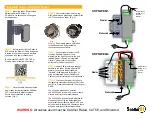
8
TK-6110
5-13. Emergency Call
When the Emergency function (key) is activated, the ra-
dio enters the “Emergency Mode”.
In this mode, the radio automatically switches to the pro-
grammed “Emergency Channel” and starts transmission
with the Emergency ID Code programmed in an installed
ANI Board (dependent on ANI board capabilities and pro-
gramming). The LCD display (Emergency Text) and the TX
LED operation are dependent on the “Emergency CH Dis-
play” settings.
6. 2-Tone
2-Tone signalling opens the squelch only when the RA-
DIO receives a proper 2-Tone code that is the same as the
pre-programmed 2-Tone for the channel. When the RADIO
receives a 2-Tone code, the CALL icon flashes.
If Transpond has been programmed, the RADIO will re-
turn an acknowledgment signal automatically after receiving
the 2-Tone code.
If Alert Tone has been programmed, an Alert Tone
sounds after receiving a 2-Tone code. Unmute condition is
canceled and the CALL icon goes off when ; (1) pressing the
[MON] Key, (2) hanging the microphone on its hook, (3) mut-
ing continues for 10 seconds. (If “Auto Reset” has been
programmed)
7. DTMF
DTMF Signalling opens the squelch only when the RA-
DIO receives a proper DTMF code that is the same as the
pre-programmed “Primary Code (Individual ; 1~7digits)” or
“Secondary Code (Group ; 1~7digits)”. When the RADIO re-
ceives a correct code, the CALL icon flashes.
If Transpond has been programmed, the RADIO will re-
turn an acknowledgment signal automatically after receiving
the DTMF code.
If Alert Tone has been programmed, an Alert Tone
sounds after receiving a DTMF code. Unmute condition is
canceled and the CALL icon goes off when ; (1) pressing the
[MON] Key, (2) hanging the microphone on its hook, (3) mut-
ing continues for 10 seconds (If “Auto Reset” has been pro-
grammed), and (4) receiving reset code. (Primary code +
“#” or secondary code + “#”)
8. Data Programming (PC Mode)
8-1. Preparation and Connection
The TK-6110 transceiver is programmed by using a per-
sonal computer, programming interface cable KPG-46, and
programming software KPG-59D.
The programming software can be used with an IBM-PC
or compatible machine. Figure 2 shows the setup for pro-
gramming.
8-2. Programming Interface Cable KPG-46 Description
The KPG-46 is required to interface the transceiver with
the computer. It has a circuit in its D-sub 25pin connector
case that converts RS-232C logic level to TTL level.
KPG-46 is used to connect between transceiver micro-
phone connector and RS-232C serial port of computer.
8-3. Programming Software KPG-59D Description
KPG-59D is the programming software for TK-6110 sup-
plied on two 3.5" floppy disks. This software runs under MS-
DOS version 3.1 or later, and Windows MS-DOS prompt on
an IBM-PC or compatible machine.
The data can be input to or read from TK-6110 and edited
on the screen. The programmed or edited data can be
printed out. It is also possible to tune the transceiver.
We recommend that install KPG-59D for example to
harddisk first then use it.
Fig. 2
OPERATING FEATURES / REALIGNMENT
KPG-46
IBM-PC
KPG-59D
TK-6110
REALIGNMENT
1. Mode
User mode
PC mode
PC programming mode
PC test mode
PC tuning mode
Panel test mode
Panel tuning mode
Clone mode
Main programming mode
Mode
Function
User mode
Customer use this mode
PC mode
Communication between the radio and
PC (IBM compatible).
It requires the KPG-59D.
PC programming
Frequency, signalling and features write
mode
to the radio and read from the radio.
PC test mode
Check the radio using the PC.
This feature is included in the FPU.
Panel test mode
Dealer uses to check the fundamental
(Refer to ADJUSTMENT)
characteristics.
Main programming
Re-write to firmware of the flash ROM.
mode









































